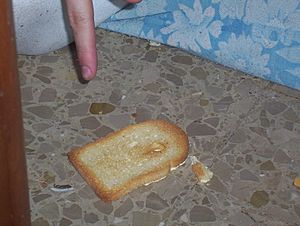Buttered toast phenomenon facts for kids
The buttered toast phenomenon is a common observation. It's about how a piece of toast with butter on it often lands butter-side down when it falls. People sometimes use this idea to describe a pessimistic (or negative) way of looking at things. Many people have tried to figure out if toast really does fall this way more often than not.
Contents
Why Does Toast Fall Butter-Side Down?
This idea has been around for a long time. Some say it's an old saying from "the north country." One of the most famous mentions is from a funny poem by James Payn in 1884:
I never had a slice of bread,
Particularly large and wide,
That did not fall upon the floor,
And always on the buttered side!
For a long time, people thought this was just a funny, negative belief. In 1991, a TV show called Q.E.D. on the BBC did a study. They found that if you throw toast into the air, it lands butter-side down about half the time. This is what you would expect by chance.
However, other scientific studies looked at what happens when toast slips or drops from a table. These studies found that it actually does land butter-side down more often! A scientist named Robert Matthews even won an Ig Nobel Prize for physics in 1996 for his work on this topic. The Ig Nobel Prize is a funny award for unusual scientific research.
The Science Behind the Fall
When toast falls from your hand, it usually slips off at an angle. This makes the toast start to spin or rotate as it falls.
Most tables are between 2 and 6 feet (about 0.7 to 1.8 meters) high. This height gives the toast just enough time to spin about half a turn. Since the toast usually starts butter-side up, spinning half a turn means it lands butter-side down.
If a table were very tall, like over 10 feet (3 meters), the toast would have enough time to spin a full circle (360 degrees). In that case, it would land butter-side up again! Also, if the toast moves horizontally very fast (over 3.6 miles per hour or 1.6 meters per second), it might not spin enough to land butter-side down.
It turns out that this common event is mostly caused by basic physics rules and how things fall.
Other Things to Consider
You might think the extra weight of the butter makes the toast fall a certain way. But scientists say the butter's weight doesn't really change how the toast falls. This is because the butter is spread out evenly.
When a piece of toast flips towards the floor, it has something called inertia. This means it wants to keep spinning once it starts. It usually only stops spinning when it hits the floor. How fast it spins and how big or heavy the toast is affects this. Since most toast slices are pretty similar in size and weight, they often fall in a similar way.
See also
 In Spanish: Fenómeno de la tostada con mantequilla para niños
In Spanish: Fenómeno de la tostada con mantequilla para niños


